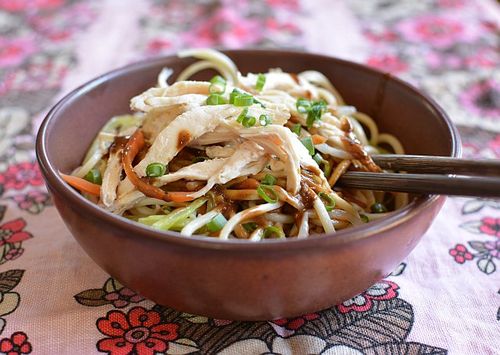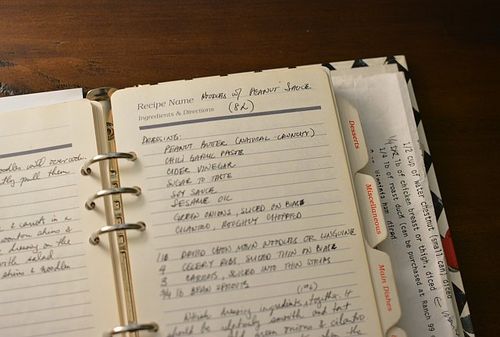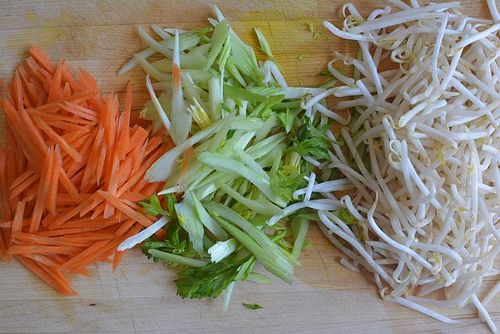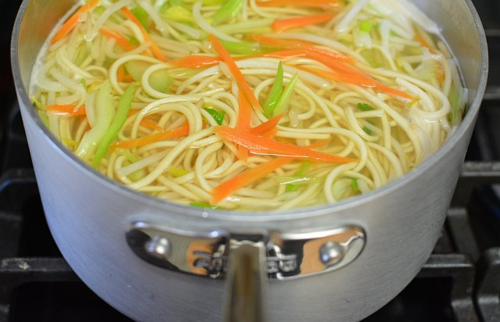After reading the dan dan noodle recipe post, Jay emailed earlier this week asking for assistance with a noodle dish that he was trying to replicate from a Bay Area restaurant named Crouching Tiger (where’s the Hidden Dragon?). He shared his sauce recipe with me and asked me to help him tweak it. I looked up the restaurant’s menu and the characters for the noodles that Jay was interested in -- “Sichuan Cold Noodles.” Then I checked out recipes for it online and in my cookbook collection.
Turns out that Jay was looking for an authentic version of Chinese peanut noodles, a dish that I made and ate with abandon in the late 1980s, early 1990s. My husband (then boyfriend) and I ordered the room temperature noodles coated in a spicy, tangy peanut butter-based sauce at Chin Chin in Brentwood, California.
At that time, the restaurant’s “noodles in peanut sauce” defined Chinese cold noodles for many people in Los Angeles. With vegetables and chicken in the mix, the Chin Chin noodles were a great one-dish meal. We were poor students and after a few rounds of takeout, I came up with my own recipe and wrote it down in a recipe keeper.
Jay’s inquiry prompted me to revisit my old recipe and prepare it this week. I made the sauce two different ways – with peanut butter and then with sesame paste. The former pays homage to delicious fusion flavors of the past and the latter reflects the sensibilities of today. Both were tasty in their own right.
Decades ago, peanut butter was a convenient stand in for sesame paste. I didn’t know squat about chile oil or Sichuan dou ban jiang chile bean sauce so I reached for sambal olek made by the Huy Fong/Rooster company. Given that, pick what you want and use ingredients you have access to. I offer options for you to tinker with and come up with something on your own. You cannot go wrong.
For convenience, I cook the noodles and vegetables in the same pot and keep them in a zip-top plastic bag in the fridge. I return them to room temperature before finishing with the sauce and protein. Hand-shredded poached chicken breast is the go-to for Sichuan cold noodles but you can instead use thin strips of seasoned pressed tofu or smoked pressed tofu (buy it or make it from Asian Tofu, pages 38 and 40).
If you opt for the chicken, cook it in the pot of water before cooking the noodles. Remove the chicken, then use the pot for the noodles and vegetables. Instead of celery, try cucumber but don’t blanch it. For the peanut butter, I prefer just ground peanuts for purity in flavor.
Gluten-free friends, try this with rice noodles like thick round bun noodles and use 3 tablespoons of wheat-free soy sauce/tamari for the regular and dark soy. See the vegetarian dan dan noodles recipe for more noodle guidance and a photo of the Chinese sesame paste. If you have a rendition of these noodles, what's your approach or secret?
Recipe
Sichuan Cold Noodles
Yields: 4 servings
Ingredients:
- 8 ounces (240 g) dried Chinese noodles or 12 ounces (360 g) fresh Chinese noodles
- 2 ribs celery, thinly sliced on diagonal (include the leaves if you like their bite)
- 1 large carrot, julienned to resemble a fat bean sprout
- 8 ounces (240 g) bean sprouts
Sauce
- 3 tablespoons Chinese sesame paste or unsalted peanut butter, or 2 ½ tablespoons tahini and 1 ½ teaspoons toasted sesame oil
- 2 tablespoons chile oil (preferably with chile flakes), Sichuan chile bean sauce (dou ban jiang), or sambal olek (Rooster brand)
- 2 tablespoons Chinkiang vinegar, or 1 ½ tablespoons balsamic and 1 ½ teaspoons cider vinegar
- 2 ½ tablespoons regular soy sauce
- 1 ½ teaspoons dark soy sauce
- 1 tablespoon sugar
- Salt, to taste
- 1 heaping teaspoon Sichuan peppercorns, toasted until fragrant in a skillet then pounded to a coarse texture
To finish
- 1 to 2 tablespoons toasted sesame oil
- 12 ounces (360 g) hand-shredded, cooked chicken breast or thin strips of pressed tofu
- 2 small green onions, green part only, cut into thin rounds
Method:
- Bring a 4-quart (4 l) pot of water to boil. Cook the noodles until they are still a bit chewy – al dente. Add the celery, carrot, and bean sprout. Stir and when the vegetables have slightly softened (there may be little bubbles at the edge of the pot), drain. Flush with water and drain well. Cool to room temperature or transfer to a container and refrigerate for up to 3 days. Return to room temperature before using.
- Meanwhile, stir together all the sauce ingredients – from the sesame paste to the sugar, until smooth.Taste and tweak the flavors for a tangy, spicy, salty and slightly sweet finish. It should be a little punchy because the other ingredients will dilute it a tad. Add the Sichuan peppercorn when you are satisfied. The sauce thickens so add 1 tablespoon water if it’s gloppy. Let rest 10 minutes before using or refrigerate for up to 3 days.
- To serve, toss the noodles and vegetables with a little sesame oil to separate things. Divided among individual serving bowls or put into a communal bowl. Plop sauce on top, add the chicken and sprinkle on the green onion. Stir together and enjoy.
Related links on VWK and elsewhere:
- Vegetarian Dan Dan Noodles
- Sichuan Chile Bean Sauce (dou ban jiang)
- Sichuan peppercorns
- Chin Chin Noodles with Peanut Sauce recipe originally from the Los Angeles Times
- Spicy Sichuan Noodles by Ken Hom in the New York Times (1991)
- Cold Spicy Sichuan Noodles from Good Food in Australia
- Sichuan Cold Sesame Noodle from Jing Theory's Chengdu family
- Cold, Tart, Nutty, Spicy Sichuan Noodles from Madame Huang (interesting foodways insights)




















